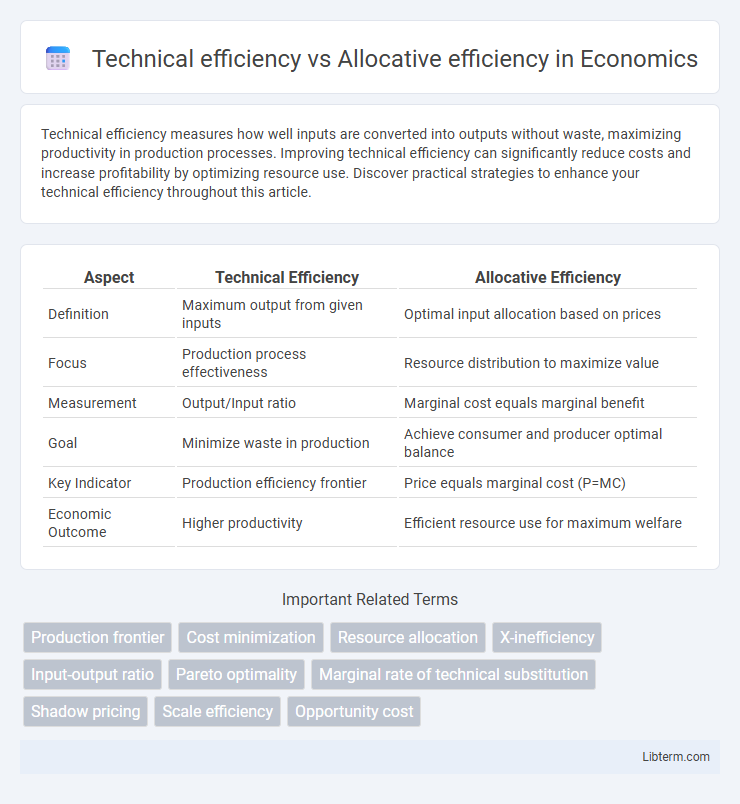Technical efficiency measures how well inputs are converted into outputs without waste, maximizing productivity in production processes. Improving technical efficiency can significantly reduce costs and increase profitability by optimizing resource use. Discover practical strategies to enhance your technical efficiency throughout this article.
Table of Comparison
| Aspect | Technical Efficiency | Allocative Efficiency |
|---|---|---|
| Definition | Maximum output from given inputs | Optimal input allocation based on prices |
| Focus | Production process effectiveness | Resource distribution to maximize value |
| Measurement | Output/Input ratio | Marginal cost equals marginal benefit |
| Goal | Minimize waste in production | Achieve consumer and producer optimal balance |
| Key Indicator | Production efficiency frontier | Price equals marginal cost (P=MC) |
| Economic Outcome | Higher productivity | Efficient resource use for maximum welfare |
Introduction to Economic Efficiency
Technical efficiency measures how well resources are used to produce a given output, minimizing waste and maximizing productivity. Allocative efficiency occurs when resources are distributed to produce the combination of goods and services most desired by society, reflecting optimal resource allocation based on consumer preferences and prices. Together, these concepts form the foundation of economic efficiency, ensuring both productive and allocative optimality within markets.
Defining Technical Efficiency
Technical efficiency measures a firm's ability to maximize output from a given set of inputs, indicating optimal resource utilization. It reflects how well production processes convert inputs such as labor, capital, and materials into finished goods or services without waste. Achieving technical efficiency means operating on the production possibility frontier, where no additional output can be produced without increasing inputs.
Understanding Allocative Efficiency
Allocative efficiency occurs when resources are distributed to produce the combination of goods and services most desired by consumers, maximizing societal welfare. It is achieved when the price of a good equals its marginal cost, ensuring that resources reflect consumer preferences accurately. This contrasts with technical efficiency, which focuses solely on producing maximum output from given inputs without considering consumer demand or price signals.
Key Differences Between Technical and Allocative Efficiency
Technical efficiency measures how well a firm uses inputs to produce maximum output without waste, focusing purely on physical productivity. Allocative efficiency evaluates whether resources are distributed to produce the optimal mix of goods that maximizes consumer satisfaction, based on relative input and output prices. The key difference lies in technical efficiency emphasizing input-output optimization, while allocative efficiency prioritizes value-based resource allocation in line with demand and cost conditions.
Measurement Methods for Technical Efficiency
Measurement methods for technical efficiency primarily involve Data Envelopment Analysis (DEA) and Stochastic Frontier Analysis (SFA), both of which assess how effectively inputs are transformed into outputs within production processes. DEA is a non-parametric linear programming method that constructs an efficient frontier from observed data, enabling comparison of each decision-making unit's efficiency relative to this frontier. SFA uses a parametric approach, incorporating a composed error term to separate inefficiency from statistical noise, allowing more nuanced estimates in the presence of random shocks.
Assessing Allocative Efficiency in Practice
Assessing allocative efficiency in practice involves measuring how effectively resources are distributed to maximize social welfare, often using shadow prices or marginal cost analysis to evaluate whether inputs align with their true economic value. Unlike technical efficiency, which focuses solely on producing maximum output from given inputs, allocative efficiency requires an understanding of market conditions and consumer preferences to ensure resources are directed toward their most valued uses. Practical assessment tools include data envelopment analysis (DEA) combined with cost or input price information, enabling policymakers and firms to identify inefficiencies related to input misallocation and improve resource utilization.
Factors Affecting Technical Efficiency
Technical efficiency measures how well a firm uses its inputs to produce the maximum possible output, while allocative efficiency assesses whether inputs are used in optimal proportions given their costs to maximize profit. Factors affecting technical efficiency include technology level, workforce skill and experience, management practices, and the scale of production. Environmental conditions and resource availability also play crucial roles in determining a firm's ability to operate at peak technical efficiency.
Determinants of Allocative Efficiency
Allocative efficiency depends on factors such as accurate price signals, consumer preferences, and market competition, which ensure resources are distributed to produce goods that maximize societal welfare. Effective government policies, including regulation and taxation, influence allocative efficiency by correcting market failures and externalities. Technological advancements and information availability also play a crucial role in aligning production with consumer demands, enhancing allocative efficiency.
Implications for Policy and Management
Technical efficiency maximizes output from given inputs, while allocative efficiency ensures resources are distributed to their most valued uses, both critical for improving overall productivity and economic welfare. Policymakers should design regulations that incentivize firms to adopt advanced technologies for technical efficiency and encourage market signals that align production with consumer preferences to achieve allocative efficiency. Management must balance cost minimization with strategic resource allocation, employing performance metrics that capture both efficiencies to optimize operational success and competitive advantage.
Conclusion: Balancing Technical and Allocative Efficiency
Balancing technical efficiency, which emphasizes maximizing output from given inputs, with allocative efficiency, which ensures resources are distributed according to consumer preferences, is essential for optimal economic performance. Firms must optimize production processes while aligning resource allocation with market demand to achieve sustainable growth and competitiveness. Strategic integration of both efficiencies leads to improved productivity and maximizes overall welfare in the economy.
Technical efficiency Infographic

 libterm.com
libterm.com